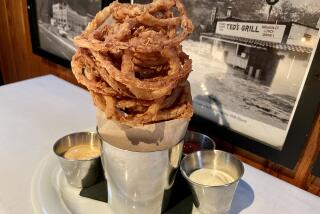GARDENING : Couple of the Year: Impatiens and Onions
- Share via
An ancient Egyptian favorite and a relative newcomer to the Western world are the National Garden Bureau’s choice for vegetable and flower of the year.
Announcement of the unusual coupling--onions and impatiens--was accompanied by this bureau comment:
“One would not grow them near each other in the garden. But both impatiens and onions are very popular with gardeners.”
No argument there. However, linking them seems sure to cause double takes. Onions and impatiens require opposite cultivation techniques. Onions need full sun. Impatiens need filtered sun but not full sun and are frost-sensitive. With those differences understood, both are relatively easy to grow.
The garden bureau, founded 75 years ago, is a nonprofit educational service of the home-garden seed industry. Most major retail and wholesale seed companies are members. It announces its winners in advance of National Garden Week April 9-15.
Impatiens are relative newcomers to the Western world. They arrived in England in 1896. Naturalist John Kirk found them growing in equatorial Africa from Mozambique to Tanganyika.
The name comes from the tendency of seedpods, when ripe, to burst open at the slightest touch and scatter seeds to the wind.
An early problem with impatiens was color. Hybridizers now have them blooming in red, orange, pink, white, lavender and bicolor. In general, the largest plants produce the largest blooms. They come in dwarf, medium and tall sizes. Flowers are single or double. Most are sold as bedding plants.
*
Onions are one of the oldest cultivated vegetables. Egyptians elevated them to deity status about 5,000 years ago, and onions are eaten in every country these days.
The basic types are storage, fresh, green and pearl or mini-onions. Colors can be white, yellow or red. The bulb shape is globe, flattened or torpedo.
“All of these differences seem fairly easy to see and accept,” says the bureau. “The difficult nature with onions is day length. This trait is not obvious and can be the reason for total failure.
“A short-day onion is responsive to 11 to 12 hours of daylight; an intermediate-day onion needs 12 to 14 hours of daylight and a long-day onion requires 14 or more hours of light. In the summer in North America, southern latitudes have shorter days while northern latitudes have longer ones.”
Onion seed may be sown directly and shallowly into the garden. Fall seeding is common in mild-winter areas. Cover lightly. Green sprouts appear in 10 to 14 days when soil temperatures are between 70 and 75 degrees Fahrenheit.
Green onions are ready to harvest in four to five weeks, when tops are about a foot high. Use them by thinning the crop for bulbs to a 4-inch spacing.
Onion sets also are popular. They are small, dormant onion bulbs ready for outdoor planting. Plant about two inches deep and a half-inch apart. Fresh green onions will be ready in about four weeks.




